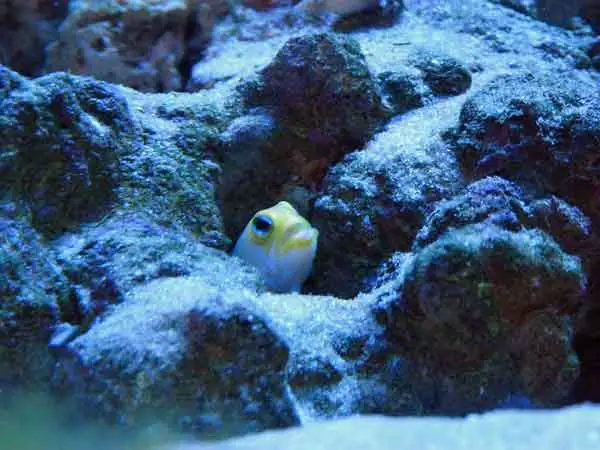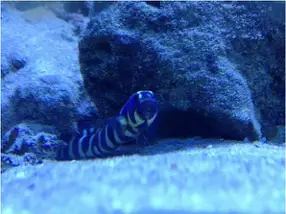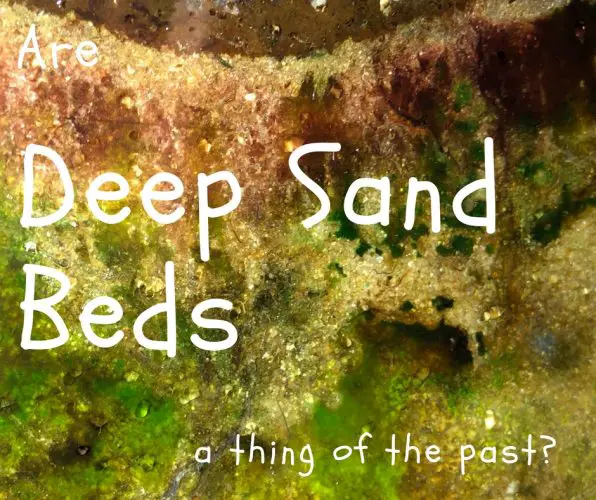When I started with this hobby, deep sand beds were trending downward on the aquarium “in vogue” list. At least, if one ever considers deep sand beds “in vogue,” anyway. (As a side note, I don’t think I’ve ever used the phrase “in vogue” before. But now I’ve done it three times in the span of 60 words!) At the moment, I’m feeling like an old guy clinging to the way things used to be and wondering, “Are deep sand beds just a thing of the past?” Am I the only one left in the hobby with a tank that has a deep sand bed? Or is there room in saltwater aquariums for this aquascape feature?
Table of Contents: Deep Sand Beds
You can’t decide if deep sand beds have reached their peak (or fallen down the other side) unless you look at both sides of the argument. And that’s what the following links will help decide. Maybe you already have your opinion firmly in hand, and you want to look at the other side. Or perhaps you aren’t convinced one way or the other. With luck, this article should help you decide whether a deep sand bed might loom in your future.

Deep Sand Beds
Let’s start with basic terminology. A deep sand bed is nothing more than a live sand filter when you get down to it. Any time you add more than FIVE INCHES (12.7cm) of sand to the bottom of your tank, you’ve ventured into the depths. And the system works because you (usually) have “sand stirrers” that move through the substrate and prevent the build-up of toxins. (We’ll tackle problems that crop up when you DON’T)
Some hobbyists go an extra step and add a plenum to their tanks. A plenum creates space under the bed of sand, forming a pocket where bacteria go to work. That way, you have active filtration working to prevent unwanted nitrates from gaining a foothold. Dr. Dean Jaubert invented this design, and it’s popular even in large, commercial setups.
Of course, plenty of hobbyists skip the plenum and allow anaerobic bacteria (those that work in the absence of oxygen) to work at the bottom of the tank. As you extend your deep sand bed, you lose oxygen. So below 2-3 inches (5-7.6cm), the anaerobes start taking over. You don’t even have to do anything! The bacteria move to the section of the bed that works best for them, breaking down waste for energy.
And, in case you wondered whether one “design” works better than the other, research shows there isn’t a ton of difference between the two options.
But, if you have filters installed for your saltwater aquarium, why add an extra? And one that looks potentially unattractive? (No one rushes to fill their display tank with piles and piles of sand) That’s where a handy comparison comes in.
Advantages of Deep Sand Beds
Obviously, I’m going to start with the advantages. I prefer the look of a deep sand bed in a tank to a bare bottom. I COULD leave the argument there, but that isn’t sporting of me. Besides, you get more advantages when you decide to go beyond the usual 2-2 inches (5-7.6cm) of an “ordinary” tank.
And, before you worry, deep sand beds work with any fine-grained substrate. You don’t need to break the bank, filling your aquarium with bag after bag of particular or special sand to get these advantages.
Water Purification
Let’s start with one of the most important parts of maintaining a saltwater aquarium: water chemistry and purification. You invest plenty of time, money, and effort in getting your water parameters perfect. That requires equipment, test kits, and the proper balance of salt mix, organisms, and filtration. So what I love, love, love about deep sand beds is the surface area for both aerobic and anaerobic bacteria to live and grow. You end up with bacterial organisms in your tank ANYWAY – and you want them. Those bacteria turn ammonia into nitrite and nitrite into nitrate. This means they shift ANY substrate into fantastic live sand.
“But Al,” you say, “the bacteria in my tank do the same thing, and I don’t have a deep sand bed.” Very true, but allow me to finish. Deep within my sand bed live those anaerobic bacteria. And they remove NITRATE directly from the water. That means an extra step you can’t get with a shallower substrate level (or a bare tank). And the more sand you have? The more room you have for bacterial colonies to grow, thrive, and filter your tank.
Deep sand beds act as a living water purification system and help clean your water – without an extra step! As you check those crucial chemistry parameters, you’ll see them stay within acceptable levels. There is no need to fuss with your salt mix, fret over dosing, or consider changing around the animals in the tank. Instead, you allow the natural processes of your miniature ecosystem to go to work.
Aesthetics
You get a distinct look for your saltwater aquarium when you choose to stick with a bare bottom for your tank. When you took the time to set up your aquarium, you decided that style worked for you. And not having to fuss with a vacuum to keep nitrates and waste from building up makes your life easy. But it doesn’t look natural.
Adding any kind of substrate to your tank increases the “wild” aspect of your tank. Your fish, crustaceans, corals, and mollusks look at home. It’s like taking a cube out of the ocean and popping it into your living room. That’s why you see plenty of aquarium supply companies and fish stores stocking sand, coral rubble, and gravel. Substrates provide a natural aesthetic in an aquarium – one your fish and invertebrates will appreciate.
Of course, that doesn’t mean you need to pile in the sand to achieve the same look. But here’s a big reason I love deep sand beds:

Critters! All sorts of tiny animals thrive inside the top layers (well, all of the layers, but you can’t see past the top unless you get a shovel and a microscope) of deep sand beds. All of the green and brown algae? The tiny worms? And those darting pods? That’s LIFE thriving away inside my aquarium. Maybe none of them are as impressive as my fish and invertebrates (it depends on your level of aquarium nerdiness), but they’re contributing to the health of my tank.
One of my favorite things to do is watch my deep sand bed at night and see what’s moving around. I can’t identify all of the microscopic organisms, but I know they’re acting as crucial “sand stirrers” for the system. As they move in and around the substrate, they shift the grains of sand. This prevents pockets of toxic gasses from building up. And – similar to the bacteria – they feed on detritus they find littering the sand. That makes them part of the clean-up crew.
Even without using live sand, you’ll find these tiny animals making themselves at home when you choose deep sand beds. They hitchhike on your live rock and settle into the cozy environment you’ve created. And as long as they aren’t causing a problem? You’ll find yourself with an active, interesting display.
Reef Life
Last but not least, deep sand beds serve as a crucial home to delightful animals you don’t want to exclude from your “must-have” list: burrowing fish. Without the resources of a deep sand bed to construct their tunnels, burrowing fish end up miserable. A hefty depth (varying depending on the species) allows these unique fish to feel safe, retreat at night, and burrow away to their heart’s content.
At different points, I’ve kept jawfish and engineer gobies. Both are fascinating to watch. Gobies seem to never stop building, forming elaborate tunnel systems that turn the bottom into an “underland” maze. And jawfishes are just amusing to watch, bobbing up and down, spooking at their own shadows, and darting back into their burrows. You’ll find yourself amazed at the activity and wonder how you ever did without a deep sand bed to house these dynamic species.

Disadvantages of Deep Sand Beds
Every coin comes with two sides. And deep sand beds – as much as I love them – aren’t for everyone. When you start exploring all the good they provide, you’ll see little problems popping up within the advantages. And if you don’t pay close attention, those benefits can quickly turn into nightmares. It’s why plenty of hobbyists avoid piling up the sand. (Not to mention why the trend goes up and down the roller coaster of “vogue”)
You probably already noticed some cracks in the deep sand bed. But to make it easy to compare the two sides of the argument, let’s explore those disadvantages in more detail.
Reef Life
Everyone loves burrowing fish (or you do now that I pointed them out to you). You can’t keep the species happy and healthy without deep sand beds. But – even with a proper environment – you can end up with problems in your tank when you invite these fish into your aquarium. The fish often secrete mucus to shore up their excavations. The mucus prevents tunnel collapse. But it’s not a substitute for concrete. And we’re still talking SAND.
That means you run the risk of seeing your live rock and coral collapse as fish burrow around in the substrate. They’re so eager to explore through the sand, they ignore the structures above. And that can lead to problems as the rock loses supporting foundations. The result? Trapped fish, injured coral, and even death. Problems you don’t need to worry about if you forgo deep sand beds.
I lost coral tissue (not the whole animal) at one point because a pair of gobies insisted on burying the polyps day after day. I solved the problem by moved the coral far enough away to avoid the exuberant digging. However, when you don’t see those tunnels (or the entrance the fish are expelling sand from), problems can arise too late for you to solve.

Cleanliness
Why do hobbyists love bare bottom tanks? They’re clean and pristine. You get a simple aesthetic that’s easy to manage. Deep sand beds, on the other hand, require more maintenance.
Sand gets dirty from time to time. (I know, that’s a weird statement to contemplate) If you’re a complete neat freak with a low tolerance for brown stuff in the tank, you’ll spend every bit of your free time (and most of your scheduled work or family time) vacuuming up the natural life accumulating across the surface of your deep sand bed. You’re going to need to resign yourself to the presence of microorganisms in your tank with all of that sand in the aquarium. And no matter how many fish or invertebrates you stock to feed on algae, you’re going to see mats develop. If you can’t STAND the sight, opt for a shallower bed.
What’s key to remember is that all of that “dirt” and movement across the sand serves a function. You’re cycling your tank. And without the excess “clutter,” you wouldn’t enjoy the benefits of an extra filter.
Anaerobic “Life”
Now, I haven’t seen this written about in a long time (probably because no one writes about deep sand beds these days), but older literature warns about a risk of “old tank syndrome” or the leaching of toxic chemicals from the anaerobic layer. And this is one of the biggest fears aquarists have about going over the standard layer of sand in their tanks. If they set up a deep sand bed, they’ll end up toxic gasses, such as hydrogen sulfide, pooling in pockets that will eventually escape to the water and kill all of the fish.
This is why you have those anaerobic bacteria, though. They work in and around the sand grains to eliminate those toxic gasses. After all, they don’t have a problem thriving in that environment. And as long as you’re allowing your “sand sifters” to happily exist, they’ll move the bed around enough to prevent a large pocket from forming. It’s why proponents of deep sand beds insist you don’t need to fuss over this “old school” warning as much as you think.
I’m not sure if it’s those tiny diggers that have kept me in the safe zone or just dumb luck, but my current tank has run for somewhere around 8-9 years with a deep sand bed. It’s as alive and vibrant as ever. I haven’t needed to cope with toxic releases or other issues. And I’d like to think it’s because I provide a comfortable environment for those anaerobic bacteria.
For More Information
Maybe you’re still on the fence about deep sand beds. That’s okay – it’s an open subject in this hobby. And you might need some additional information to make an informed decision. Which is what you’ll find here.
How about a YouTube video describing the differences between shallow and deep sand beds?
Or maybe you know deep sand beds are for you. This YouTube video will walk you through everything you need to know:
Intrigued by those burrowing fish I mentioned? Here are a few more that live for the tunnel life:
Conclusion
I guess I’m old school. (I’ve certainly always been stubborn) I love my deep sand bed, and I’m convinced it provides biological filtration and stability to my tank, allowing me to be more laid back about maintenance. I also love my burrowing fish and the additional tiny critters that make the layers of sand their home. To me, that makes keeping an extra depth of sand in my tanks worth it. (Even if I have a “messy” substrate)
Am I the only one out there? Let me know what type of sand bed you have with a comment below.


Leave a Reply to Timothy A Manning Cancel reply